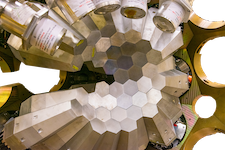Speaker
Description
A.J. Boston, H.C. Boston, L. Harkness-Brennan, E.S. Paul, University of Liverpool, UK
J. Nyberg, Uppsala University, Sweden
P.H. Regan, Zs. Podolyàk, University of Surrey, UK
P-A. Söderström, ELI-NP, Romania
J. Simpson, M. Labiche, STFC Daresbury Laboratory, UK
M. Bentley, University of York, UK
J. Smith, University of the West of Scotland, UK
We propose to investigate the high spin evolution in the doubly midshell nucleus 170Dy and its near neighbours in an experiment with AGATA + PRISMA + DANTE. This proposal is the continuation of a series of experiments which have furthered our knowledge and understanding of the physics of nuclei in this mass region. The aim is to maximise the potential offered by the increase in γ-γ efficiency provided by the AGATA array and the unique supporting infrastructure available at LNL for this campaign.
The nucleus 170Dy has the largest value of the proton-neutron valence product, NpNn, of all nuclei with A < 208. Theoretical predictions suggest that 170Dy may be one of the stiffest axially deformed nuclei in nature [1], which has significant consequences for the robustness of the K quantum number. In addition, 170Dy may represent the best case of the SU(3) dynamical symmetry of the interacting boson approximation of all nuclei.
The structure of 170Dy is challenging to study experimentally. A number of attempts have been made using projectile fragmentation of a lead beam [2]; multi-nucleon transfer reactions between 82Se and 170Er, where a 4+ -> 2+ ground-state band transition candidate at 163 keV was first reported [3], and in-flight fission from where an isomeric state was observed [4]. The most recent work was published [5] in 2016 by Söderström et. al. Nuclei in the 170Dy region were produced by in-flight fission of a 345 MeV/u 238U beam on a Be target at RIBF in RIKEN. Utilising the BigRIPS separator, gamma-ray transitions were identified using a time window of 0.3 – 0.6μs after 170Dy implantation. The three lowest-lying excited states identified were assigned as the 2+, 4+ and 6+ members of the yrast ground-state rotational band, confirming the earlier assignment as the 4+ -> 2+ .
In this proposal we suggest populating 170Dy by +2p-xn (x>1) transfer reactions using a 900 MeV 136Xe beam on a self-supporting 0.5 mg/cm2 thick 170Er target. According to results of GRAZING calculations 170Dy can be populated with a cross-section of 1.3 mb for this reaction. The beam-like fragments will be identified by the PRISMA spectrometer complemented by the DANTE detector array for additional channel selection based on isomer tagging. By gating on the strongly populated delayed γ rays in 134,136Ba, it will be possible to identify decays in the binary partners 168,170Dy. The advantages of using AGATA coupled to PRISMA and DANTE in this experiment is the high γ-ray efficiency (particularly the γ- γ efficiency), excellent Doppler correction and isomer tagging capabilities of AGATA, the very good A, Z identification and velocity vector determination of PRISMA and the high efficiency and precise determination of the angle of the target-like fragments of DANTE. The efficacy of this approach was illustrated by the tentative identification of excited states in 170Dy achieved in an earlier work [3] with the CLARA + PRISMA setup and a 82Se beam. The use of a 136Xe beam will give a large increase of the yield of neutron-rich reaction products as well as of the angular momentum transferred to the fragments, compared with the 82Se induced reaction.
In the proposed experiment, we estimate an increase of the number of counts in the 4+->2+ transition in 170Dy by a factor of about 100 compared with the earlier work. In addition, we expect to considerably increase the knowledge of the high-spin structure of 168Dy up to and beyond the backbending region. Estimates of yields based on the previous CLARA + PRISMA experiment and on GRAZING calculations indicate that we also may be able to identify higher lying excited states for the in the nuclei 166Gd , 168Gd , 172Dy and 174Dy.
[1] P. Regan et al., Phys Rev. C 65, 037302
[2] Zs. Podolyák, et al., in: J.H. Hamilton, W.R. Phillips, H.K. Carter (Eds.), Proc. of the Second Int. Conf. on Fission and Properties of Neutron-Rich Nuclei, St. Andrews, Scotland, 1999, World Scientific, 2000, p. 156.
[3] P.-A. Söderström, et al., Phys. Rev. C 81 (3) (2010) 034310.
[4] D. Kameda, et al., RIKEN Accel. Prog. Rep. 47 (2014)
[5] Söderström et.al. Physics Letters B 762 (2016) 404–408

